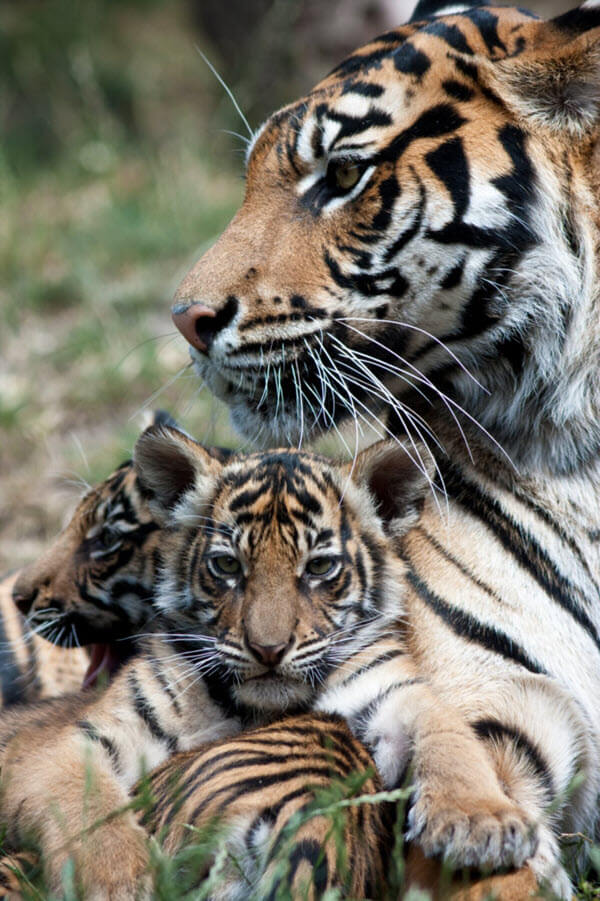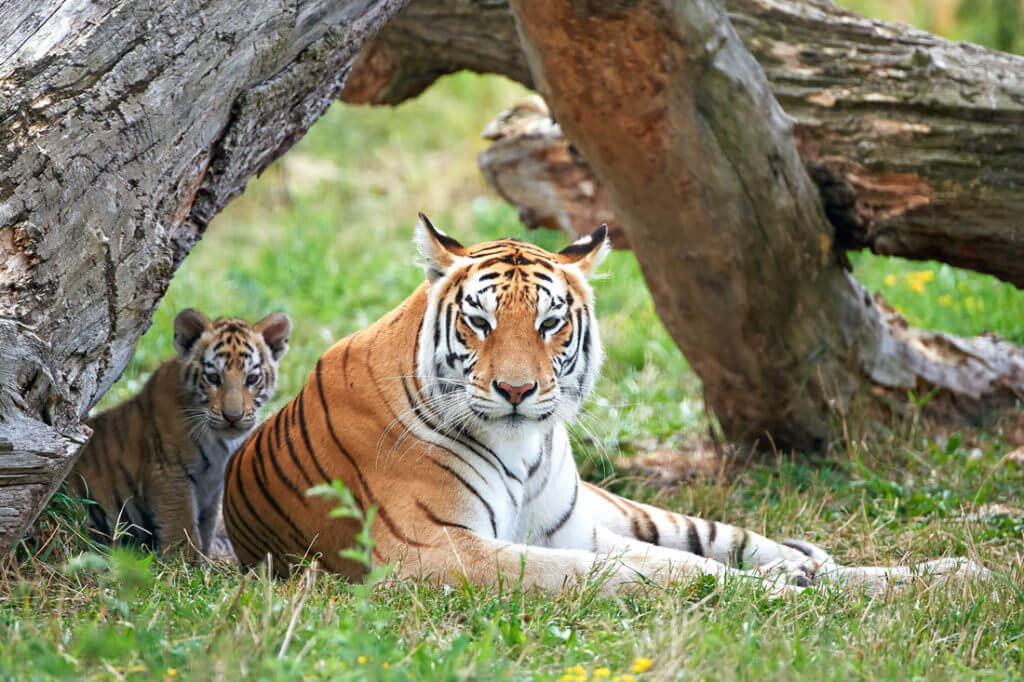The tiger is the biggest cat on the planet. Tigers are also an Endangered species. In addition to having lost over 90% of their original habitat, they have been aggressively hunted and poached. The current population of tigers in the world is believed to be between 3,000 and 4,000.
The oldest known tiger species lived over 2 million years ago during the Pleistocene epoch (Ice Age). It was the size of a jaguar – much smaller than the tigers we see today.
Tigers can be found throughout history in the art, literature and folklore of many different societies. It is the national animal of four countries – South Korea, Malaysia, India and Bangladesh.
The tiger has a very large and powerful body, with strong front legs and a big head. The cat’s fur is usually a variation of orange with dark stripes.
Scientific Name: Panthera tigris
Conservation Status: Endangered
Subspecies: AS of 2017, there are only two recognized tiger subspecies:
- Panthera tigris tigris (tigers inhabiting continental Asia) – the Bengal tiger, Siberian (Amur) tiger, South China tiger, Indochinese tiger, Malayan tiger and Caspian tiger (extinct)
- Panthera tigris sondaica (tigers inhabiting the Sunda islands) – the Sumatran tiger; and two extinct island tigers, the Javan tiger and the Bali tiger.
Some interesting tiger facts
- Tigers are larger than any other wild cat.
- They have the biggest canines (long, pointed teeth) of any cat.
- Tigers are the third largest carnivore (meat eater).
- Tigers like water and swim.
- They are the only cat species that is totally striped.
More about tigers
Physical appearance
 Tigers are known for their black stripes. Their fur varies in color from white to golden. A white tiger is not an albino. Their white appearance is the result of a genetic variation – a recessive gene. White tigers are either pure or part Bengal tiger, and usually bred in zoos. It is rare to see a white tiger in the wild. They do not live as long as golden-colored tigers and many have crossed eyes.
Tigers are known for their black stripes. Their fur varies in color from white to golden. A white tiger is not an albino. Their white appearance is the result of a genetic variation – a recessive gene. White tigers are either pure or part Bengal tiger, and usually bred in zoos. It is rare to see a white tiger in the wild. They do not live as long as golden-colored tigers and many have crossed eyes.
Male Siberian tigers can grow up to 12 ft. long and weigh as much as 675 lbs. Female tigers are between 6.5 to 9 feet long and weigh between 140 to 370 lbs. A tiger’s tale is 2 and 3.6 ft. in length.
Where tigers live
Tigers could once be found throughout Asia. During the past 100 years, their numbers have plummeted from approximately 100,000 to less than 4,000. Within the past 15 to 20 years, their range has also decreased by over 40%. Many tigers live in the forest, but you can also find them in grasslands and places where there are hills and rocks. They are also excellent swimmers and like being near water. Tigers generally lead solitary lives in established territories, although they are also considered “social.”
The largest population of wild tigers is in India.
Hunting and prey (diet)
 Tigers have been seen hunting during the day and night. They prefer medium to large hoofed animals such as deer, boar and buffalo, as well as domestic livestock and, on occasion leopards, dogs, crocodiles and bears. They have also been seen eating vegetation. Sometimes a tiger will share its kill with another tiger. The tiger’s hunting success rate is only 10 to 20 percent.
Tigers have been seen hunting during the day and night. They prefer medium to large hoofed animals such as deer, boar and buffalo, as well as domestic livestock and, on occasion leopards, dogs, crocodiles and bears. They have also been seen eating vegetation. Sometimes a tiger will share its kill with another tiger. The tiger’s hunting success rate is only 10 to 20 percent.
Reproduction and lifespan
Males and females will typically mate from November to April. There are generally 2 to 3 cubs in a tiger litter, with a range of 1 to 6. Cubs will usually stay with their mother until they are 2 to 2 ½ years old. Sometimes a male tiger will help raise the cubs. Tigers live between 20 and 26 years, both in captivity and in the wild.
Key conservation issues
The tiger has been hunted relentlessly for its skin and body parts. Most black marketers involved in the tiger parts trade are based in China. There are also “farms’ where the tigers are being bred for their parts. It is estimated that there are between 5,000 and 10,000 tigers currently living on these farms – more than the current wild tiger population.


Comments
Tiger — No Comments
HTML tags allowed in your comment: <a href="" title=""> <abbr title=""> <acronym title=""> <b> <blockquote cite=""> <cite> <code> <del datetime=""> <em> <i> <q cite=""> <s> <strike> <strong>